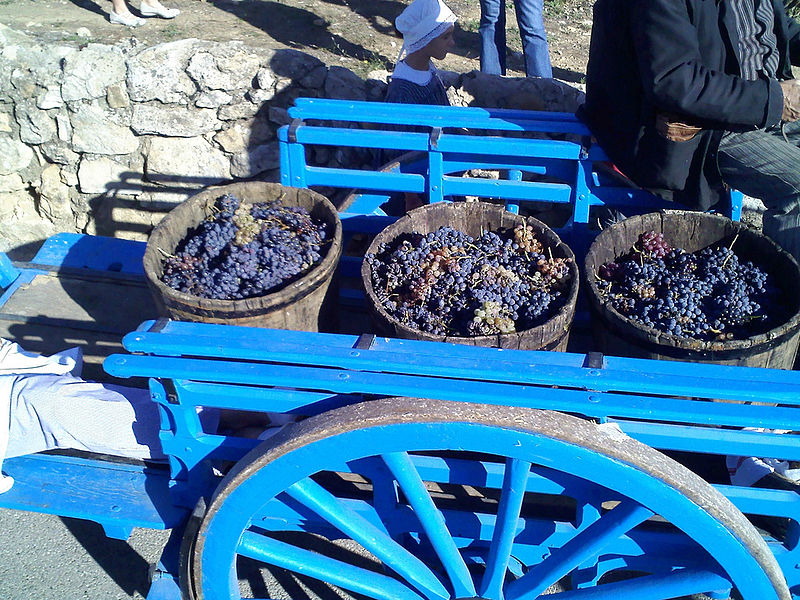15 June 2012
Volcanic impacts on everyday life — circa 1600
Posted by kramsayer

To find out what impact a massive Peruvian volcanic eruption in 1600 had worldwide, geophysicist Kenneth Verosub is looking to historical records, including the dates of grape harvests in France. (Credit: kmaschke, via wikimedia commons)
GeoSpace is in Selfoss, Iceland this week, reporting from AGU’s Chapman Conference on Volcanism and the Atmosphere. Check the blog for posts on the science presented at the meeting, as well as field trips to nearby volcanoes and geologic features.
Selfoss, Iceland — Massive volcanic eruptions that spew sulfur-rich particles into the atmosphere can disrupt climate around the globe, leading to cooler temperatures worldwide. Researchers can track the impacts by looking at ice cores that record snowfall, or examining tree rings that record summer growth. But a different approach involves scouring through historical records, to see what kind of an impact these volcanic explosions had on everyday life.
“What I’m trying to do is put a human face to these eruptions,” said Kenneth Verosub, a geophysicist at the University of California, Davis. He is examining the climate impacts of massive volcanic eruptions, the most recent of which was the eruption of Indonesia’s Tambora in 1815. The year following Tambora’s eruption was dubbed the “Year Without a Summer,” and saw a global temperature drop of 0.4 to 0.7 degrees Celsius (0.7 to 1.2 degrees Fahrenheit). The temperature change devastated crops and livestock in much of the Northern Hemisphere.
But historical records for eruptions before that – including for the 1600 eruption of Huaynaputina in Peru – are harder to come by. Verosub presented his most recent findings of the still-in-progress research Thursday at the American Geophysical Union’s Chapman Conference on Volcanism and the Atmosphere in Selfoss, Iceland.
He is collaborating with historians to delve into world agricultural and climate records, looking at dates of harvests, tree flowerings, the freezing and thawing of rivers, and several other potential indicators of global cooling for the years following these large, sulfur-ejecting events.
With a historian friend, for example, Verosub searched through Spanish archives in Seville, thumbing through handwritten letters from then-Spanish colonies. Among letters dated 1601 and 1602, the years right after the Peruvian eruption, one from Bolivia mentioned an unusual occurrence of ice in a mine. It was just one of several letters from operators of gold and silver mines in locations from New Mexico to Chile explaining to the king that they couldn’t meet their quotas.
“The fact that this was regional, and continent wide, suggested that there might have been weather problems or climate problems, or diseases,” Verosub said.
In France, information about the date of the first grape harvest to make wine has been kept for centuries, he said. When he looked at a chart of that information, the 1601 was one of the latest harvests noted.
Some of Verosub’s sleuthing has been serendipitous. While on a flight to Houston, he was seated next to a historian who told him about the Russian famine of 1601, the worst in Russian history. It was caused by a period of persistent cold and wet weather that made it impossible to plant and grow crops, the historian said. And again, it followed the 1600 Peruvian eruption.
Verosub has many other places he’d like to search, and people he’d like to talk to. One historian, for example, has looked at the employment records for Scandinavian bricklayers. The mortar used then to hold bricks together would not set in freezing temperatures, so years with relatively early end of employment dates for bricklayers may indicate lower-than-usual temperatures, Verosub said. The challenge is to find funding, and time, to investigate such questions.
The goal in all cases is to find any anomalies that could be tied to an eruption-induced cold spell. Accurate thermometers were decades away in 1601, and so volcanologists have to look elsewhere to determine temperatures in other ways.
“I found that historians were very receptive and very willing to help,” Verosub said. “The idea of an interdisciplinary collaboration was very appealing to them.”
–Eric Villard and Kate Ramsayer, AGU


 GeoSpace is a blog on Earth and space science, managed by AGU’s Public Information staff. The blog features posts by AGU writers and guest contributors on all sorts of relevant science topics, but with a focus on new research and geo and space sciences-related stories that are currently in the news.
GeoSpace is a blog on Earth and space science, managed by AGU’s Public Information staff. The blog features posts by AGU writers and guest contributors on all sorts of relevant science topics, but with a focus on new research and geo and space sciences-related stories that are currently in the news.